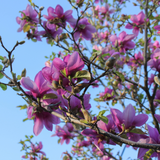When should I plant Magnolia Susan?
It is best to plant deciduous Magnolias when they are dormant, throughout late autumn or winter (providing it is not freezing), or in spring during the cooler climates. This ensures the plants have a good chance of settling down before summer.
How far apart should I plant Magnolia Susan plants?
If you purchase medium sized Magnolia plants (around 60-90cm), we recommend planting no more than 2 per metre (50cm spacing). For plants taller than 1m, a space of 100cm between each plant is best.
As Magnolia is very wide spreading, the correct spacing is key when it comes to planting, as they need plenty of room to grow to be able to grow to their full potential.̴Ì?
How to plant Magnolia Susan:
As Magnolia has quite shallow roots, you will not need to dig a very deep hole.
Begin by digging a hole that is a little wider than the root ball, but the same depth as the pot the plant came in (usually around 20-30cm). Then add some fresh topsoil, well-rotted compost, or leaf mould into the excess soil. Set aside.
Place the plants carefully into the hole, ensuring they're straight, and check the level they are sitting at in the ground - the base of the stem should be at or just above ground level. Backfill with soil, patting gently as you go along, to knock out any air. Follow this with watering in well.
We then recommend adding around 2-3" of mulch at the base of the plant, too. Anything like garden compost, grass cuttings, bark, or wood chippings works well.̴Ì?
Ensure you continually water the plant throughout the first 1-2 years after being planted (we recommend around 2-3 times per week, and more so during warmer weather). This is a very important step as the roots need plenty of water and nutrients to be able to establish and develop successfully.̴Ì?











